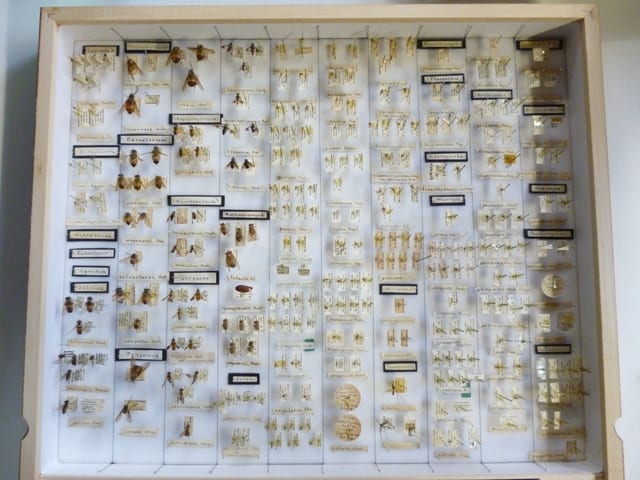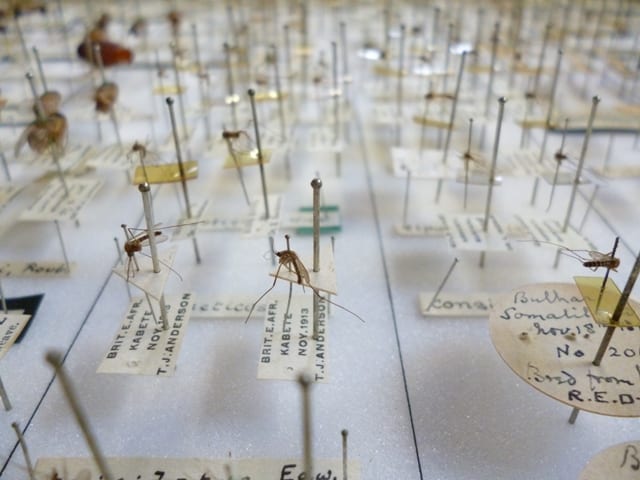Time, Flies and the Origins of Crowdsourcing
By Mark Carnall, on 12 July 2013
Aside from jelly beans, the current Octagon Exhibition, Digital Frontiers, is dominated by objects from the Grant Museum of Zoology. Well, at least in terms of numbers because we’ve loaned this entomology drawer containing over 250 fly specimens. My colleague Nick Booth wrote about his experience of installing the objects from the collections he curates (and his experience was far more leg work than moving this single drawer was) and researching this drawer of flies in order to loan it revealed a lot of interesting information about this otherwise niche collection of insects: in natural history museums entomology collections are normally measured in the millions.

Fly specimens in drawer labelled ‘From Small cabinet 3’ from the Grant Museum entomology collections
As the curator of a smallish museum with a bit of everything and a big backlog of documentation and identification work, a lot of my time is spent identifying ‘rabbit holes’- areas of research on the collections for the future that I don’t have time to go down myself. When we use objects, for example, loaning them to internal exhibitions like Digital Frontiers, I can dip a bit deeper into the objects before they go out on loan.
As previously mentioned, the entomology collections at the Grant Museum are relatively tiny. There’s less than 20,000 pinned insects. Most of them are British Lepidoptera, moths and butterflies, from two collections the Finzi and Walker collections and the rest of the material pinned in drawers is a mixed assortment of material that came to UCL from other London universities and institutions when their teaching and research collections were closed down. This drawer along with two others is simply labelled “From Small Cabinet”. However, because every scientist who dares call themselves an entomologist understands the importance of the information that travels with specimens there is plenty of data on the labels for these flies including- the collection place, date and the collector. Sadly, sometimes these labels are more durable than the specimens they should be associated with, the collections at the Grant Museum have been ravaged by pests a number of time in the past as evidenced here.
Skimming the labels for these specimens, which are a mix of mosquitos, black flies and horse flies (sadly no elephant flies), these specimens were collected by a range of collectors between 1911 and 1916 from across Africa; German East Africa, British East Africa, Mt. Mulanje (Malawi?), Nyassaland, Gold Coast, Uganda, Durban, Sierre Leone and Zanzibar. The difficulties in resolving old place names with their current geographical descriptions is a blog post for another time. There are also a couple of specimens from Hong Kong, Italy and much closer to home, Hampshire.
Researching the collectors, including names like Dr W.A. Lamborn, G.D.H Carpenter, S.A.Neave, Dr A.H. Wilson, Dr A.Ingram, Dr W.M. Aders, Dr J.W.S Macfie, W.H.Patterson and Dr H Macfarlane, a number of these entomologists appear to have worked at or done fieldwork for the London School of Hygiene & Tropical Medicine (LSHTM), which only a couple of hundred metres from the Grant Museum’s current premises. G.D.H Carpenter, did a lot of work on tse-tse flies and sleeping sickness on behalf of the LSHTM. He later went on to work on mimicry in butterflies and pioneer ecological genetics. Amongst taxonomic literature and exhaustive notes on mammals he collected, S.A.Neave read an account before the Royal Geographical Society of his travels along the Congo-Zambezi watershed noting the many insects he saw. Dr W.M. Aders was an economic botanists in Zanzibar. Dr J.W.S Macfie worked across Africa and the Middle East studying insect bourne diseases. Along with hundreds of other leading entomologists, all of these collectors are recorded in the Bulletin of Entomological Research as donating hundreds of specimens to the Imperial Bureau of Entomology (now the Commonwealth Agricultural Bureaux International).
Quite how this small part of the sizeable collections these gentlemen collected ended up at UCL is unclear, especially given that they regularly donated their research material to the Imperial Bureau of Entomology. Perhaps these insects ended up forgotten at the LSHTM? Perhaps (and I hope not) they were borrowed from another institution and never returned. Perhaps they were previously used in a course about economic and medical entomology.
In the context of the Digital Frontiers exhibition, these specimens nicely illustrate the idea that the very modern concept of crowdsourcing has a long and rich history in natural history collecting and collections. At any one moment in time, the natural world is vast and in it’s whole uncollectable, but the aggregated collections from collectors like the ones here, through to hobbyists, gentlemen scientists, scientific institutes and biological surveys make up the very fragmented historical collection of the biological world now housed in museums like the Grant Museum. Along with written records, these collections are the evidence base for what species may be doing at any one time. At the very least this is interesting to chart the evolution and adaptation of life over time. At the other end of the spectrum, field research and collections like these are critical for looking at climate change, extinction and at the most selfish extreme charting and stopping the spread of diseases, agricultural pests and other impacts on our rather luxurious (in this part of the World) but increasingly threatened way of life.
Mark Carnall is the Curator of the Grant Museum of Zoology
 Close
Close



